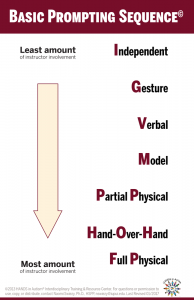2 Implementation Supports
 In addition to the foundation, the process throughout the House Model is supported with common strategies central to the implementation. These strategies include prompting, differential reinforcement and team collaboration
In addition to the foundation, the process throughout the House Model is supported with common strategies central to the implementation. These strategies include prompting, differential reinforcement and team collaboration
Prompting
Understanding how to prompt or help guide your student or child without providing too much help is important for building independence and ensuring that students do not become prompt-dependent. To help understand what level of prompt to use, a prompting hierarchy can illustrate how to progress through the stages of prompts.
Often, we start with the least intrusive (lowest level) and move to more intrusive (highest level) prompting. As with everything, there are exceptions to the rules when you may look to move from the highest to the lowest level of prompting. To learn more about prompting check out our E-Learning course Prompting for Success.
 Through a virtual environment, prompting can and should look slightly different from when used in the classroom. Teaching students to use resources embedded into the programs they are using for virtual learning can help increase success. A teacher might model through sharing their screen or having the student share their screen and using an annotation feature. Other examples include utilizing chat functions to give a student a prompt privately vs giving the prompt to the whole class or group.
Through a virtual environment, prompting can and should look slightly different from when used in the classroom. Teaching students to use resources embedded into the programs they are using for virtual learning can help increase success. A teacher might model through sharing their screen or having the student share their screen and using an annotation feature. Other examples include utilizing chat functions to give a student a prompt privately vs giving the prompt to the whole class or group.
By nature of working remotely, a teacher who is not physically with their students cannot prompt beyond modelling without assistance from parents or caregivers who are with the student in person. Functions such as chat can help a teacher ask a parent to provide additional prompts such as a hand over hand or fully physical prompt to complete the task at hand.
Collaboration
Working through this virtual time has helped emphasize the importance of good collaboration between families and the school/teacher. Good collaboration helps ensure critical information is shared between families and those working with their students. This way students are able to be more successful.
 Teachers sharing what supports have worked at school with parents can help parents better work with their child. Parents sharing what has or hasn’t worked at home can allow for teachers and other school personnel to help brainstorm and determine solutions to difficulties. Without strong collaboration, everyone is likely to feel frustrated, including the student.
Teachers sharing what supports have worked at school with parents can help parents better work with their child. Parents sharing what has or hasn’t worked at home can allow for teachers and other school personnel to help brainstorm and determine solutions to difficulties. Without strong collaboration, everyone is likely to feel frustrated, including the student.
There are several ways to encourage strong collaboration. First and foremost, establish a good way to communicate with your child’s teacher/your student’s parents and/or caregivers. Opening this line of communication from the beginning ensures you are able to work together throughout the school year. One way to help ensure good communication is through using a home-school communication form and a parent preference form to get everyone on the same page.
Another way to help with collaboration is ensuring other school personnel are on the same page. Using a specialist communication form can ensure that questions are being asked and answered, and information is being shared with the right people. Sharing information with others who may interact with your student(s) can also help to ensure success for students. Handouts such as tips for bus riders can help ensure that all aspects of school are able to be successful with whatever blend of at home or in school education a family chooses.
Additionally the use of google forms sent to families or other teachers can help to provide necessary information about students. The responses of these forms can then be put together and provided to those needing that information. Using a QR code for the google form can help reducing needing to send the form over and over again and provide quick and easy access to reaching the forms.
The use of email and various apps such as Class Dojo, Remind, and Seesaw just to name a few, are also great ways to stay in communication with families and caregivers. Finding a communication system that works for all involved will help keep open lines of communication when needed and everyone on the same. page.
Differential Reinforcement
 Having reinforcement for students is an important aspect motivating them to do and complete work. One of the ways to reinforce students is through praise. Giving praise that is specific and positive can be enough to keep students on track and working. Through specific positive attention, students know exactly what they did correctly and are able to look to perform the same behaviors again. Our Positive Attention handout provides information that will show when and how to use specific praise throughout the learning process.
Having reinforcement for students is an important aspect motivating them to do and complete work. One of the ways to reinforce students is through praise. Giving praise that is specific and positive can be enough to keep students on track and working. Through specific positive attention, students know exactly what they did correctly and are able to look to perform the same behaviors again. Our Positive Attention handout provides information that will show when and how to use specific praise throughout the learning process.
Some students need additional supports to stay motivated. Using a reward system to reinforce their activities by working towards getting a preferred item or activity after can help to keep students on task and working! Creating a reward system does not have to be difficult. Using the steps in our Reward System How-to can help to get a system in place if you student needs more motivation than what positive attention is providing.
Encouraging and reminding of desired behaviors typically following a hierarchy
